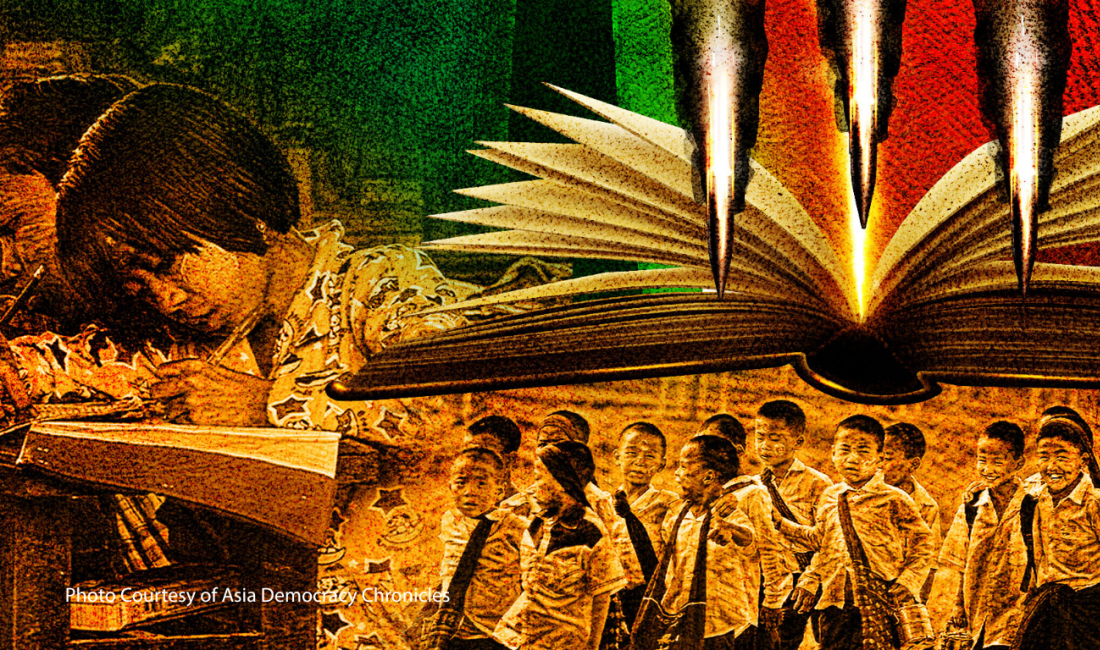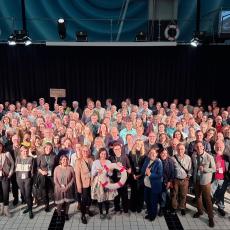In Myanmar, Schools Are Bombed, Teachers Hunted—and Education Is Defiance
This piece was produced and first published by Asia Democracy Chronicles.
Since grabbing power from a democratically elected government more than four years ago, Myanmar’s military has used airstrikes, raids, and arrests not only to wage war against resistance forces, but also to dismantle the country’s future by attacking one of its most vital lifelines: education.
According to records from the Democratic Voice of Burma (DVB), at least 57 schools were hit by airstrikes in the first half of 2025 alone. Last January, the junta, which now calls itself the State Administration Council or SAC, had its jets dropping bombs eight times on Aung San Comprehensive University in central Myanmar.
A 20-year-old student was killed while five other individuals, including professors, were wounded.
Four months later, a SAC airstrike on a school in Ohe Htein Twin Village in the northwestern Sagaing region killed at least 20 students and two teachers. In fact, as of this June, nearly 1,000 airstrikes have already been recorded, with the Sagaing region—a stronghold of resistance—being the most heavily targeted.
Even after a devastating earthquake struck many areas in Myanmar in March, SAC air raids did not cease.
A researcher monitoring SAC atrocities after the earthquake confirmed that at least 30 of those post-quake airstrikes targeted schools and delayed recovery efforts.
Last year, 129 schools were either damaged or completely destroyed in airstrikes. Between 2021 — when the military took over Myanmar’s government — and 2023, at least 137 schools suffered similar fates.
SAC has consistently denied targeting schools for deadly assaults, blaming such incidents instead on resistance forces or describing reports on these as “fake news.” But few doubt the veracity of the reports and the identity of the culprit behind the deeds. Many also see the attacks as reflecting the junta’s broader strategy to destroy intellectual infrastructure and suppress critical thinking.
Yet in the face of military violence and brutality, Myanmar’s resistance-controlled areas are not merely holding ground; they are cultivating a future.
At the heart of this effort lies a quiet but powerful revolution in education, one that focuses not only on survival but also on building the human resource foundation for long-term development, especially in rural regions devastated by war and neglect.
Practical Lessons
In Sagaing Region, which has seen some of the most intense airstrikes and ground assaults by SAC, Chindwin Comprehensive University (CCU) stands as a beacon of grassroots resilience. Located in the heart of the Anyar region – Myanmar’s central Dry Zone – CCU was established on August 8, 2023. (The 8th of August is especially significant to the people of Myanmar as a popular uprising began on this day in 1988. Although the protest was crushed by the military, the day marked a turning point in Myanmar’s democracy movement.)
CCU has designed its curriculum to directly respond to the most urgent challenges: food insecurity, climate vulnerability, disrupted local economies, and rural livelihoods destroyed by war. These programs aim to restore the region’s food systems, revive smallholder agriculture, and regenerate rural life.
Recognizing that rural livelihoods and food systems form the backbone of Myanmar’s recovery, CCU has crafted a plan to develop livestock training, and veterinary treatment education. These efforts aim to equip young people in resistance-controlled areas with the knowledge and skills needed to sustain agriculture, improve animal health, and generate local income through livestock and value-added food production.
The Anyar Region certainly needs any help it can get. Historically rich in agriculture and home to a large rural population, it now faces enormous challenges. SAC’s trade blockades, frequent confiscation of land, and targeting of local infrastructure—combined with climate disruption and conflict displacement—have shattered traditional farming practices and supply chains.
Many farmers have been forced to flee; others have lost their tools, seeds, and access to irrigation.
Against this backdrop, institutions like CCU are providing hope and direction along with education. At CCU, students undergo intensive training in livestock management, sustainable crop production, soil restoration, farming, and local economic planning. They are also introduced to value-added rural development models—learning how to turn small-scale production into community wealth through food processing, local market development, and cooperative entrepreneurship.
Yet the curriculum emphasizes not just technical skills, but also community leadership. Students are trained to become practitioners and change agents who can rebuild their own villages and contribute to decentralized governance and local administration.
“Our university is not just an academic space,” says CCU President Ko Ko Aung. “It is a training ground for those who will heal the land, feed the people, and lead the recovery of Anyar, Sagaing, and Magway. We are committed to this vision not just for now, but for the future. Education is the most important first step in rebuilding this country from the ground up.”
Beyond Sagaing, the emergence of sector-specific educational hubs continues to gain ground. In Karenni State in eastern Myanmar, Karenni Medical College—established by health professionals and educators in the Civil Disobedience Movement (CDM)—has successfully trained two batches of medical practitioners who now serve rural populations lacking access to state health systems. In Northern Shan, Kachin, and Ta’ang regions, underground educational networks have created learning spaces for basic healthcare, teacher training, and public administration—core competencies needed for local governance and public service delivery in liberated zones.
Relearning How to Hope
Not all the learning take place in regular classrooms, of course. Some are done in mobile format, despite the challenges of finding signals. Others have temporary set-ups. A teacher in a township administered by the parallel National Unity Government (NUG) admits;
“We want to rebuild our schools, but we are afraid. There might be an airstrike during the construction—or worse, they might target the new school even after it’s completed. That’s why we decided to proceed with temporary shelter-based schools. These are not ideal spaces for our students to learn, but we have no other choice.”
Temporary or not, these educational initiatives are aligned with the resistance movement’s broader vision: to lay the institutional and human groundwork for a federal democratic future. Although underfunded, they fill a vacuum left by the collapse of SAC-run public services, while also proactively training a new generation of professionals, farmers, administrators, and health workers.
“We are building a chain of human resources—step by step, brick by brick,” says a resistance education officer from Sagaing. “These students and educators are the backbone of the future federal union. When the day comes, we will not start from zero. We will already have our own doctors, teachers, local officials, and agricultural leaders.”
Ironically, the resistance’s education efforts have been bolstered by the steady arrival in NUG-administered areas of professional educators. As the junta continues to crack down on CDM members and supporters, hundreds of teachers, professors, and administrators have been facing persecution, interrogation, detention, and criminal charges. Some have even been tortured and killed. Many have had no choice but to flee their homes and seek safety in areas controlled by Ethnic Resistance Organizations (EROs).
“I cannot live in my home due to the charges against me for participating in CDM by SAC,” says one displaced teacher. “I fled and found a safe space in the Karenni area. Now, I and other CDM teachers work together to support and help establish a physical education space for the development of this region. This is our way of paying back the gratitude to the community that helped us in our time of crisis—and in doing so, we are helping rebuild the country as well.”
Such stories are not rare. In Karenni, Karen, Kachin, and Ta’ang regions, networks of displaced educators have come together to build schools, community learning centers, and even higher education institutions. Far from being just classrooms where students have their lessons, these have become sanctuaries of hope and resilience.
In the midst of a civil war, these spaces are nurturing a new generation of thinkers, technicians, farmers, and medical professionals who are essential to the future of federal, democratic Myanmar.
Through these resistance-led institutions, Myanmar’s people are surviving the onslaught while cultivating the seeds of recovery, sovereignty, and self-reliance.
What the SAC seems to have failed to grasp—or perhaps fears most—is that education is not merely about acquiring knowledge. It is about power, identity, and possibility. In resistance zones, education is both a shield and a sword—fortifying young people against ignorance and equipping them to reclaim their future.
“They should not destroy what they do not understand,” another education officer in a Sagaing township says of the junta. “The SAC is not only destroying our future, but also every attempt to save it.”
Undoubtedly, SAC’s airstrikes, persecution, and negligence during natural disasters are designed to silence. But in classrooms hidden in forests, in underground learning centers, and in makeshift universities across Myanmar, voices rise; teachers teach, students learn, and communities resist.
Because education, in this context, is more than a right. It is resistance. It is survival. And it is the only path forward.



